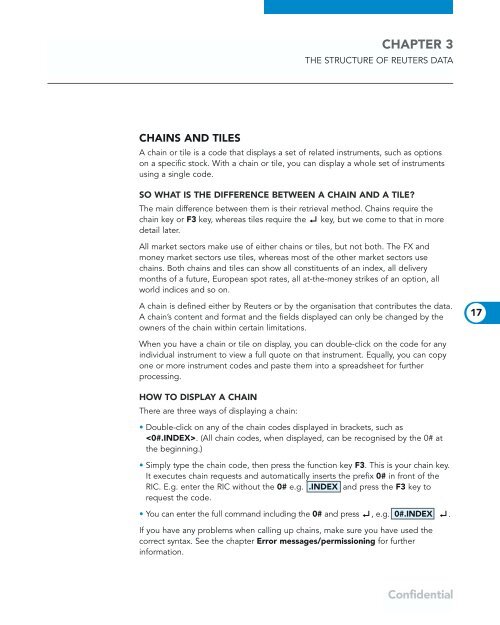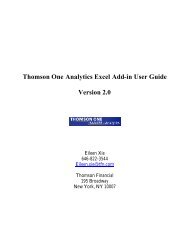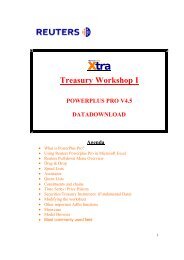How to find data on Reuters quickly and easily - News
How to find data on Reuters quickly and easily - News
How to find data on Reuters quickly and easily - News
Create successful ePaper yourself
Turn your PDF publications into a flip-book with our unique Google optimized e-Paper software.
CHAPTER 3<br />
THE STRUCTURE OF REUTERS DATA<br />
CHAINS AND TILES<br />
A chain or tile is a code that displays a set of related instruments, such as opti<strong>on</strong>s<br />
<strong>on</strong> a specific s<str<strong>on</strong>g>to</str<strong>on</strong>g>ck. With a chain or tile, you can display a whole set of instruments<br />
using a single code.<br />
SO WHAT IS THE DIFFERENCE BETWEEN A CHAIN AND A TILE?<br />
The main difference between them is their retrieval method. Chains require the<br />
chain key or F3 key, whereas tiles require the key, but we come <str<strong>on</strong>g>to</str<strong>on</strong>g> that in more<br />
detail later.<br />
All market sec<str<strong>on</strong>g>to</str<strong>on</strong>g>rs make use of either chains or tiles, but not both. The FX <strong>and</strong><br />
m<strong>on</strong>ey market sec<str<strong>on</strong>g>to</str<strong>on</strong>g>rs use tiles, whereas most of the other market sec<str<strong>on</strong>g>to</str<strong>on</strong>g>rs use<br />
chains. Both chains <strong>and</strong> tiles can show all c<strong>on</strong>stituents of an index, all delivery<br />
m<strong>on</strong>ths of a future, European spot rates, all at-the-m<strong>on</strong>ey strikes of an opti<strong>on</strong>, all<br />
world indices <strong>and</strong> so <strong>on</strong>.<br />
A chain is defined either by <strong>Reuters</strong> or by the organisati<strong>on</strong> that c<strong>on</strong>tributes the <str<strong>on</strong>g>data</str<strong>on</strong>g>.<br />
A chain’s c<strong>on</strong>tent <strong>and</strong> format <strong>and</strong> the fields displayed can <strong>on</strong>ly be changed by the<br />
owners of the chain within certain limitati<strong>on</strong>s.<br />
When you have a chain or tile <strong>on</strong> display, you can double-click <strong>on</strong> the code for any<br />
individual instrument <str<strong>on</strong>g>to</str<strong>on</strong>g> view a full quote <strong>on</strong> that instrument. Equally, you can copy<br />
<strong>on</strong>e or more instrument codes <strong>and</strong> paste them in<str<strong>on</strong>g>to</str<strong>on</strong>g> a spreadsheet for further<br />
processing.<br />
17<br />
HOW TO DISPLAY A CHAIN<br />
There are three ways of displaying a chain:<br />
• Double-click <strong>on</strong> any of the chain codes displayed in brackets, such as<br />
. (All chain codes, when displayed, can be recognised by the 0# at<br />
the beginning.)<br />
• Simply type the chain code, then press the functi<strong>on</strong> key F3. This is your chain key.<br />
It executes chain requests <strong>and</strong> au<str<strong>on</strong>g>to</str<strong>on</strong>g>matically inserts the prefix 0# in fr<strong>on</strong>t of the<br />
RIC. E.g. enter the RIC without the 0# e.g. .INDEX <strong>and</strong> press the F3 key <str<strong>on</strong>g>to</str<strong>on</strong>g><br />
request the code.<br />
• You can enter the full comm<strong>and</strong> including the 0# <strong>and</strong> press , e.g. 0#.INDEX .<br />
If you have any problems when calling up chains, make sure you have used the<br />
correct syntax. See the chapter Error messages/permissi<strong>on</strong>ing for further<br />
informati<strong>on</strong>.<br />
C<strong>on</strong>fidential










